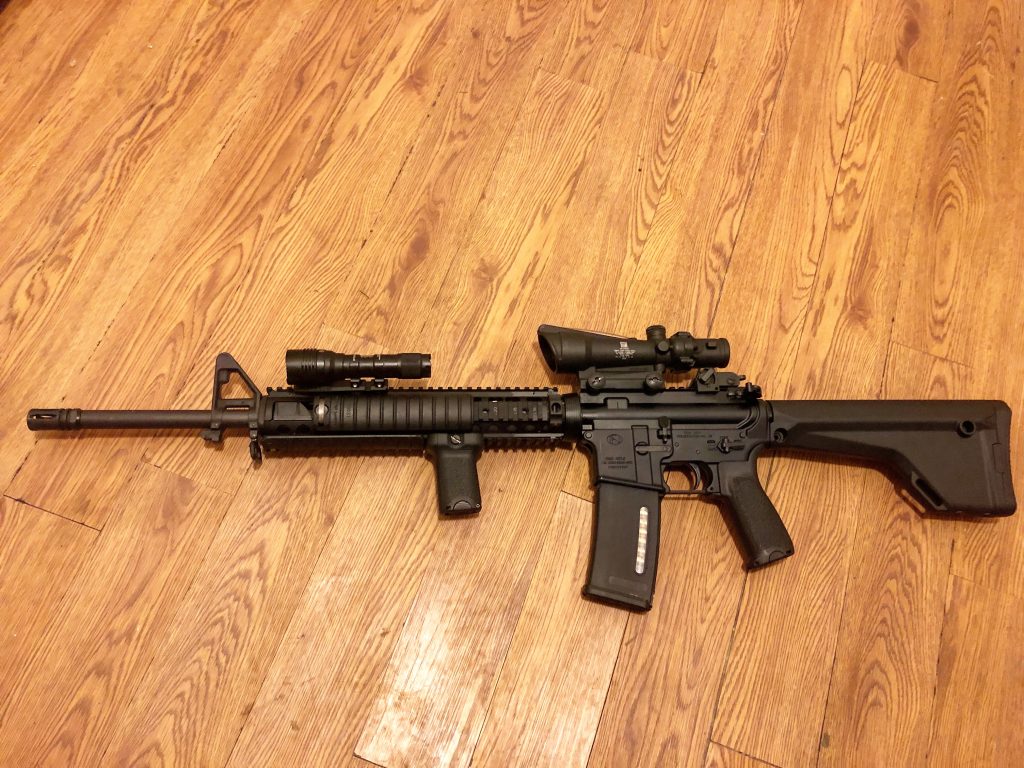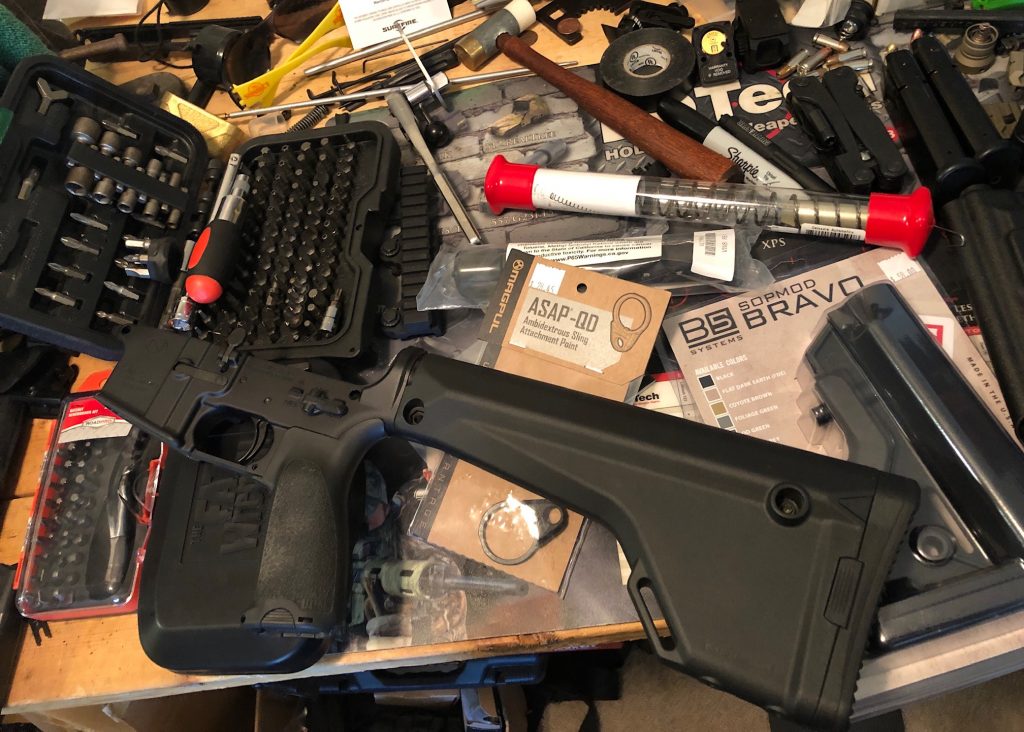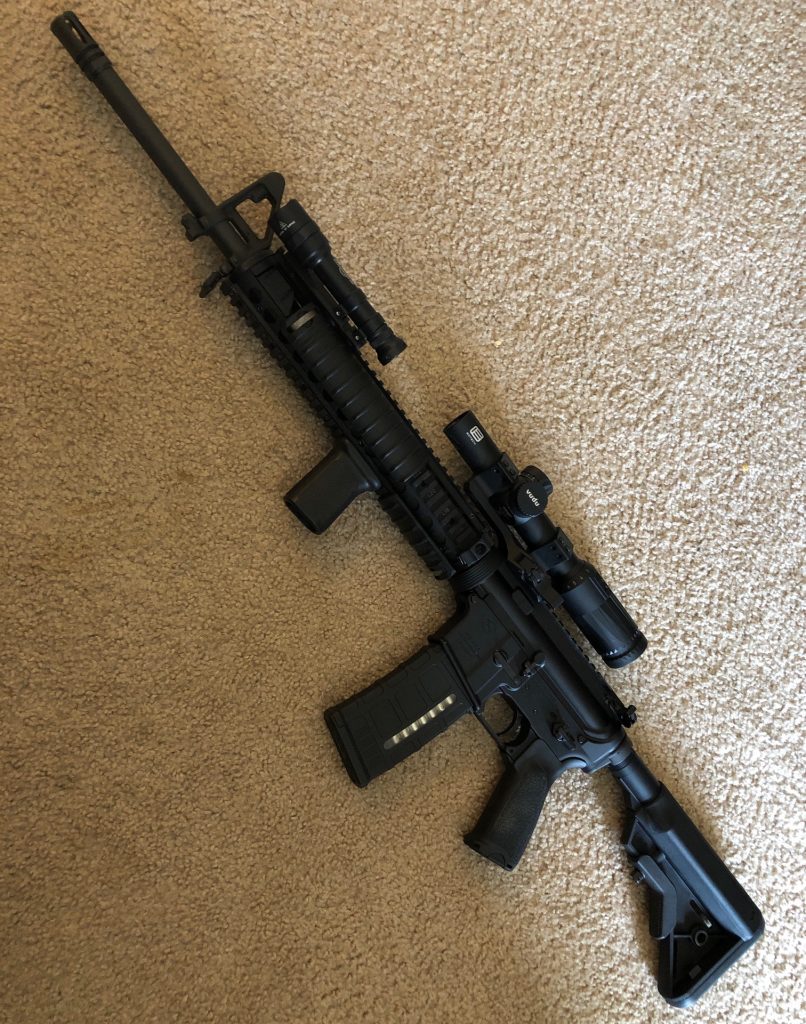
The M16A4 was first introduced in 1997 with production sweeping outward in services for the next decade. In 2007 I was still issued an A2 variant for basic training, by the time I left MCRD San Diego A4’s were in circulation. I received an M16A4 when I landed in my slot at 1st Battalion 24th Marines but it had none of the optical goodies yet. We were heavy into GWOT in both theaters and the cool toys stayed overseas with the troops actually shooting at people. Within a year, I believe, we had ACOGs and PEQ lasers for our M16’s and small selection of M4’s.
There was an ongoing debate (some fueled by angry rhetoric from a rather pompously stupid officer) on what to do to keep the M16 (and M4) current or replace them. Tech has developed at an astounding pace and mistakes continued to be made when it came to equipment, mostly small but they were still there. Institutional stagnation played a role as units were cautious about implementing solutions, though often designed by the very war-fighters using the systems, and the have rifles suffered as a result.
A 2002 study had found that the M4 was less reliable than the M16 (99.73% overall reliability for the M4 vs 99.91% for the M16), mostly due to the fact they hadn’t figured out everything they had to do to the gas system and buffer yet. Not a surprising finding considering the AR-15 family was always envisioned as a 20″ barreled rifle system. But this led to the USMC hanging onto the M16A4 as the “3 times more” reliable system it was, even as both the M4 and M16 continued to receive internal improvements to tighten reliability numbers even further.
A decade and change later a study was released by the Marine Corps in February 2015 that outlined several changes that could be inexpensively made to keep the M16A4’s current. In parallel timing a small number of adjustable stock kits made their way out into the fleet to assist Marines of smaller stature. Another initiative during this time period was partnered with VLTOR Weapon Systems to knock out two items simultaneously, add adjustable stocks and further increase reliability.
A study of significant changes to Marine M16A4 rifles released in February 2015 outlined several new features that could be added from inexpensive and available components. Those features included: a muzzle compensator in place of the flash suppressor to manage recoil and allow for faster follow-on shots, though at the cost of noise and flash signature and potential overpressure in close quarters; a heavier and/or free-floating barrel to increase accuracy from 4.5 MOA (Minute(s) Of Angle) to potentially 2 MOA; changing the reticle on the Rifle Combat Optic from chevron-shaped to the semi-circle with a dot at the center used in the M27 IAR‘s Squad Day Optic so as not to obscure the target at long distance; using a trigger group with a more consistent pull force, even a reconsideration of the burst capability; and the addition of ambidextrous charging handles and bolt catch releases for easier use with left-handed shooters.[183] – Summary of Marine Corps Times Article, Wikipedia

All these separate items conglomerated into the concept of an ‘M16A5’, despite it never really being a single project. The USMC would ultimately end up shifting M4’s to their infantry instead pursuing the A5, matching a move by the US Army.
The ‘A5’ died…
As a military project at least. I did my personal variant of the concept last year. It was envisioned as a least invasive modification that encapsulated most of the items the Marines had on their ‘wish list’ from 2015.
It turned out rather well but still had some short comings (especially for short folk). One year later, I’m moving forward with another phase of improvements.
M16A5-I (Improved)


Two omissions originally made in my variant of the M16A5 compared to the 2015 USMC list were freefloating the barrel and an adjustable stock with upgraded buffer system. In the intervening time new products have been introduced to further enhance what can be offered to the AR-15 end user and I took some of those into account with my choices.
There is still no great way to freefloat the barrel of an M16, especially if you desire a front sight post gas block. That, to me, is just part of what makes an M16 an M16 still. Remove it and we essentially have a new Gucci AR variant and the M16 is no more.
Note: I see the Geissele URGI as an essentially new rifle too, where the early SOPMOD rails that kept front sight gas blocks on M4’s still kept them as M4’s. That is purely my internal logic, not any SOCOM nomenclature or secrets inside the military rifles.
I may (and I stress may, I do not see it as essential, just desirable) add a non-freefloating M-LOK handguard to replace the KAC M5 RAS. This would (assuming using the Midwest Variant and not a new design) shave 40% off the weight of the rifle’s handguard and bring it to modern ancillary specs. This option does omit the heat shield inside the RAS but opens the barrel up to more air-cooling and M-LOK panels that are heat resistant are prevalent.
The jury is out on that mod, but it is available. Picatinny is still the international standard, while M-LOK exists to omit unneeded rail space. It has the benefit of being structurally superior also. Grips and a few lights have added direct to M-LOK mounting options but optics are still rail mounted, rail is great for building interfacing recoil support, and they are likely to remain rail mounted for a long time yet.
Improved Stock and Receiver Extension (Buffer Tube)
I did opt to add an adjustable stock to the M16… finally.

Originally when I chose the Magpul Rifle MOE Stock it was for that least invasive upgrade potential. The MOE only required a single screw (and the careful detainment of a tiny spring for the rear takedown pin) to change over. It added the better cheek weld surface, improved length of pull (reduced to A1 length), and increased sling compatibility.
It did not give adjustment. The MOE is just as fixed as the A2. It fits a greater percentage of users to a more comfortable degree but it can still suffer from the ‘one size fits one/none‘ problem. To a much lesser degree mind you but it is still present. The M16A5 I had finished would still not adequately fit folks of small stature. It fit my stature for more modernized shooting but I’m the stature the A2 and A4 were built around in the first place.
So, in recognition of their contribution to the USMC A5, I chose a VLTOR receiver extension. Not their A5 7-position though, a shorter 5-position standard M4 length one (more on that in a moment). Any decent M4 tube will do, but the VLTOR has numbers to reference position and that is nice.
Onto that tube went the B5 Systems SOPMOD Bravo. The Bravo omits the waterproof ‘hide a snack/battery’ tubes of the original SOPMOD and has an improved shoulder interface geometry. “Storage” stocks and grips have always seemed to be a solution in search of a problem, nice but overall far from essential. What was essential were QD sling swivel slots, and the Bravo has them right where I want them.
Bonus: Way less beard hostile then the EMOD, a stock I do otherwise like.
Since I was adding an adjustable stock I also needed a receiver end plate. This doesn’t need to be fancy, it can be the boring old M4 piece that costs a few dollars. I put the Magpul ASAP-QD on.
Will I use that added socket? Probably not, but it is there for a one-point sling for a reason. I rigged an M16A4 with industrial metal zip-ties in years past to do what that end plate gives me, and does so much more easily and securely… seriously the A4 has no good sling compatibility, it’s still the weakest point in my opinion on the M4/M4A1 and M16A4’s in service and we’ve known better for years!
Anyway, new receiver extension/buffer tube, stock, and end plate with proper staking. Seriously, staking the end plate is the easiest thing and then the castle nut won’t walk. Do it. Hammer and a cheap punch, one whack, done.
Improved Buffer and Recoil Spring
There’s no great mystery to my choice here. The A5 receiver extension, buffer, and spring system work very well. But my personal favorite system is the Geissele Super 42. And given that the Super 42 with H1 was on the shelf (and is recommended for rifle length systems) while the A5 was not, the Super 42 got the win.

As the improved trigger system is also a Geissele (SSP) adding a second/subsequent part to source for the M16A5-I parts list was an easy choice.
Improved Optics and Light
Last year the ACOG was still retained as the optic of choice for the M16A5. There was flexibility in the choice between the improved TA31 RCO, TA11 SDO (which was on it), and a Gen2 TA50. I still recommend ACOGs, they are a simple robust optical solutions.
LPVO’s are the future standard, however. The Marine Corps took the leap by announcing the upgrade to the VCOG 1-8x as the new Squad Common Optic (SCO). I will probably join them in that choice at my financial leisure. Several fine LPVO choices in 1-6x and 1-8x exist today and a standard setting 1-10x will be arriving next month.

The EOTech VUDU 1-6x is currently the serving sight. I learned to love LPVO’s on this optic out at Thunder Ranch. It made 400 yard shots a joke, 500 a breeze, and 600 worth taking. That was with a 14.5″ rifle. Giving it 5.5″ of extra powder burning (velocity building) time in the barrel only makes 5.56 rounds happier on terminal effects, especially the heavier ones.
Am I saying the VUDU is the sight? No. But it is one on a list of quality options to fill the role and until I get the Trijicon, for largerly nostalgic reasons, it’s going to serve. EOTech’s on Military rifles still feel right, and SOCOM continues to agree.
Fun Fact: SOCOM re-chose the EOTech even after the whole thermal drift lawsuit fiasco. The improved sight was the best for what they wanted.
Light
I’m not running night vision so no PEQ, DBAL, or MAWL, subject to change but not relevant for my equipment at this moment. Instead a Surefire M600DF Scout gives me plenty of workable light for what I need. A Cloud Defensive or Modlite are equally/even more serviceable options for this role. Streamlight’s are still the choice budget conscious option.
So there you have it, the M16A5-I. Mine is built on the FN15 Military Collector Series but an Aero Precision or BCM URG will serve just as well if you want to do something on the concept. And a lot of us have time right now.



